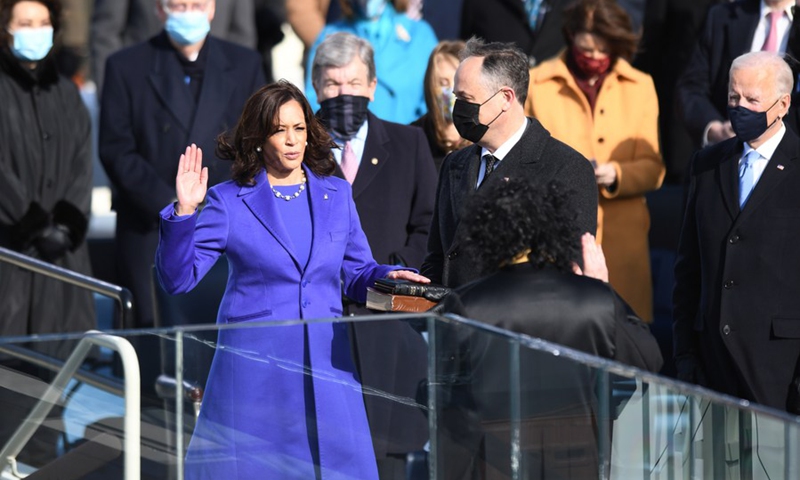Senior US officials’ “unusually frequent” visits to the Southeast Asian nations expose both Washington’s anxiety and declining confidence in marshaling regional countries against China, analysts said, after US Vice President Kamala Harris, hard on the heels of Secretary of State Antony Blinken and Defense Secretary Lloyd Austin, is set to visit Southeast Asia.
Analysts warned that such high-profile visits may fail to live up to Washington’s expectations, as its “lip service” diplomatic tactics will struggle to lull regional countries to fall into the US’ “us or them” trap.
Blinken will attend virtual meetings for five consecutive days starting on Monday, including annual meetings of the 10 ASEAN foreign ministers and other nations and separate meetings of the Lower Mekong sub-region countries Myanmar, Cambodia, Laos, Vietnam and Thailand, the US State Department announced on Saturday.
“The Secretary will reaffirm the United States’ commitment to ASEAN centrality and to working with ASEAN and international partners to combat the COVID-19 pandemic and support economic recovery,” said the department.
In recent years senior US officials have not always attended ASEAN meetings and have sometimes sent more junior officials to the region’s summits, per Reuters.
Blinken’s attendance at those virtual meetings comes after Austin concluded his visits to Singapore, Vietnam and the Philippines last week and Vice President Kamala Harris’ scheduled visits to Singapore and Vietnam later in August.
Analysts called the slew of US officials’ interaction with Southeast Asian countries as “unusually frequent.”
It shows that US has attached great importance to ASEAN countries considered the rising influence of China in the region, particularly after China-ASEAN trade reached a record high amid the COVID-19 pandemic. There has been deepened vaccine cooperation, which has underscored the significance of China-ASEAN ties, Xu Liping, director of the Center for Southeast Asian Studies at the Chinese Academy of Social Sciences, told the Global Times.
He noted that the foreign ministers of major ASEAN countries recently visited China, enhancing face-to-face interaction with Chinese officials, which creates huge pressure on the US, driving the Biden administration to strengthen its engagement with the region.
During the Special ASEAN-China Foreign Ministers’ Meeting in Celebration of the 30th Anniversary of Dialogue Relations held in Southwest China’s Chongqing Municipality in June this year, Chinese State Councilor and Foreign Minister Wang Yi said that China and the bloc should forge a higher level of strategic partnership and build a closer community with a shared future in the following 30 years.
Lü Xiang, a research fellow at the Chinese Academy of Social Sciences pointed out that top US officials’ frequent interaction with Southeast Asian states is mirrored by its anxiety and declining confidence in marshalling those countries against China.
“A warm bilateral tie isn’t pulled closer by constant visits, it is glued together via mutual benefits,” said Lü, noting that many Southeast Asian countries have seen through the US’ “lip service” diplomacy, thus the more those high-level officials visit, the sooner they will realize their reputation is being whittled away.
ASEAN became the No. 1 trading bloc with China in 2020, with trade volumes hitting 4.74 trillion yuan ($731.9 billion). Regional countries have been actively participating and profiting from the China-proposed Belt and Road initiative. Moreover, China has offered timely supply of COVID-19 vaccines to those countries.
In contrast, although Biden labeled Asia as a linchpin of his foreign policy agenda, senior officials from his administration waited months to visit the region, after they met face-to-face with officials in Japan, India and South Korea.
Lü pointed out that it is noteworthy that Austin tweeted nothing negative about China after the defense secretary concluded his visits to the three Southeast Asian countries, despite US media, such as CNBC, predicting that criticizing China on the South China Sea issue topped Austin’s agenda.
This clearly shows regional countries’ reluctance in picking sides between the two countries, and this stance will not change no matter how many times senior US officials visit those countries, the expert said.
Xu said that Austin’s recent visit aims to align US allies in the Asia-Pacific region to counter China, as the Philippines is a traditional ally of the US. The US official hoped to further align countries like Singapore and Vietnam, which are on Harris’ itinerary as well.
The intention is clear as US officials hope to strengthen security cooperation with these two countries by pushing Vietnam to play a bigger role of disruptor on the question of the South China Sea and making Singapore a planner in geopolitical balancing, said Xu, noting that the visit would be symbolic, and therefore unlikely to yield much concrete results. One of the biggest concerns for ASEAN countries is how to successfully overcome the epidemic, for example, how much the Biden administration can help in containing the virus spread by providing effective assistance such as vaccine supply.
So far, the scale of assistance is limited, as the US always has to consider its own interests as a priority. The Biden administration will not provide security promises to Vietnam without reservation, as there is still a lack of trust between the two countries despite the South China Sea issue to be discussed, according to Xu.
U.S. Vice President-elect Kamala Harris (L, Front) is sworn in as the 49th Vice President of the United States in Washington, D.C., the United States, on Jan. 20, 2021.(Photo: Xinhua)



